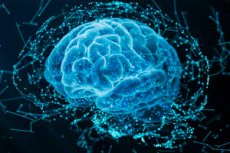Nye publikasjoner
Forskere identifiserer en ny nevroplastisk mekanisme knyttet til læring og hukommelse
Sist anmeldt: 02.07.2025

Alt iLive-innhold blir gjennomgått med medisin eller faktisk kontrollert for å sikre så mye faktuell nøyaktighet som mulig.
Vi har strenge retningslinjer for innkjøp og kun kobling til anerkjente medieområder, akademiske forskningsinstitusjoner og, når det er mulig, medisinsk peer-evaluerte studier. Merk at tallene i parenteser ([1], [2], etc.) er klikkbare koblinger til disse studiene.
Hvis du føler at noe av innholdet vårt er unøyaktig, utdatert eller ellers tvilsomt, velg det og trykk Ctrl + Enter.

Nevroner er viktige, men de er ikke de eneste aktørene i prosessen. Det er faktisk «brusken» i form av klynger av ekstracellulære matriksmolekyler kalt kondroitinsulfater som ligger på utsiden av nervecellene, som spiller en nøkkelrolle i hjernens evne til å tilegne seg og lagre informasjon.
En studie publisert i tidsskriftet Cell Reports beskriver en ny mekanisme for hjernens plastisitet, eller hvordan nevrale forbindelser endres som respons på ytre stimuli. Artikkelen har tittelen «Fokalklynger i den perisynaptiske matrisen fremmer aktivitetsavhengig plastisitet og hukommelse hos mus».
Dette arbeidet er et resultat av et samarbeid mellom Harvard Medical School, Universitetet i Trento og det tyske senteret for nevrodegenerative sykdommer (DZNE) i Magdeburg.
«Sanseferdigheter og evnen til å forstå omgivelsene våre er avhengig av hjerneaktivitet, som lar oss oppfatte og bearbeide stimuli fra omverdenen. Gjennom hjernen vår er vi i stand til å tilegne oss og lagre ny informasjon, samt huske informasjon vi allerede har lært», sier Yuri Bozzi og Gabriele Cellini.
«Dette fascinerende fenomenet er muliggjort av hjernens evne til kontinuerlig å endre strukturen og effektiviteten til nevrale forbindelser (synapser) som respons på ytre stimuli. Denne evnen kalles synaptisk plastisitet. Å forstå hvordan synaptiske endringer skjer og hvordan de bidrar til læring og hukommelse er en av de største utfordringene innen nevrovitenskap.»
Yuri Bozzi er professor ved Universitetet i Trento og medforfatter av artikkelen. Gabriele Cellini er førsteforfatter av studien. Cellini begynte å jobbe med dette prosjektet i 2017 som postdoktor i laboratoriet til Sabina Berretta (McLean Hospital og Harvard Medical School, Boston) og fullførte den vitenskapelige publikasjonen mens han jobbet som postdoktor i Bozzis laboratorium ved Universitetet i Trento.
I sentrum av studien står kondroitinsulfater, molekyler som er godt kjent for sin rolle i leddene. Disse molekylene spiller også en viktig rolle i hjernens plastisitet, siden de er en integrert del av hjernens ekstracellulære matrise, slik de opprinnelig ble oppdaget av Dr. Alexander Dityatevs gruppe i 2001.
I 2007 beskrev en japansk studie tilstedeværelsen av kondroitinsulfatklynger, runde i formen og spredt tilsynelatende tilfeldig i hjernen. Arbeidet ble imidlertid glemt inntil Sabina Berrettas translasjonsbaserte nevrovitenskapelige laboratorium brakte strukturene tilbake inn i det vitenskapelige søkelyset ved å gi dem nytt navn til CS-6-klynger (for kondroitinsulfat-6, som identifiserer deres nøyaktige molekylære sammensetning) og viste at strukturene er assosiert med gliaceller og er sterkt redusert i hjernen til personer med psykotiske lidelser.
Så, i 2017, fikk Gabriele Cellini, nyansatt i Berrettas laboratorium, i oppgave å avdekke funksjonen til disse klyngene.
«Vi undersøkte først disse strukturene i detalj, og avbildet dem med svært høy oppløsning. Vi fant ut at de i hovedsak var klynger av CS-6-belagte synapser organisert i en tydelig gjenkjennelig geometrisk form. Deretter identifiserte vi en ny type synaptisk organisering», sier forskerne.
«På dette tidspunktet måtte vi bli litt 'eksperimentell kreativ'. Ved å bruke en kombinasjon av atferdsmessige, molekylære og sofistikerte morfologiske tilnærminger, innså vi at disse forbindelsene innkapslet i CS-6-klynger endrer seg som respons på elektrisk aktivitet i hjernen.»
«Til slutt, takket være samarbeidet med Alexander Dityatev fra DZNE Magdeburg og innsatsen til Hadi Mirzapurdelawar fra hans gruppe, reduserte vi uttrykket av CS-6 i hippocampus (hjerneområdet som er ansvarlig for romlig læring) og demonstrerte at tilstedeværelsen av CS-6 er nødvendig for synaptisk plastisitet og romlig hukommelse», påpeker Bozzi og Cellini.
«Dette arbeidet baner vei for en ny måte å se på hjernefunksjon på. Det er mulig at alle synapser dannet på forskjellige nevroner i CS-6-klynger har evnen til å reagere sammen på spesifikke eksterne stimuli og delta i en felles funksjon rettet mot lærings- og hukommelsesprosesser», bemerker de.
«De ser ut til å representere et nytt substrat for informasjonsintegrasjon og assosiasjonsdannelse på flercellulært nivå», legger Dityatev og Berretta til.
Dette arbeidet er et resultat av samarbeid mellom flere laboratorier, inkludert Translational Neuroscience Laboratory (Sabina Berretta; McLean Hospital - Harvard Medical School, Boston), Neurodevelopmental Disorders Research Laboratory (Yuri Bozzi; CIMeC - Interdisciplinary Center for Brain Science, University of Trento) og Molecular Neuroplasticity Laboratory (Alexander Dityatev; DZNE Magdeburg).
